While Michigan is best known for the Ruby-throated Hummingbird, an astonishing array of rare and vagrant hummingbirds have occasionally made appearances across the state. These visitors—often from the western United States or even Central America—delight sharp-eyed birders and add surprise sparkle to backyard feeders and lakeside habitats. This guide highlights seven exceptional species of hummingbirds rarely seen in Michigan, offering tips on identification, behavior, and where these elusive gems have been spotted.
1. Rufous Hummingbird (Selasphorus rufus)
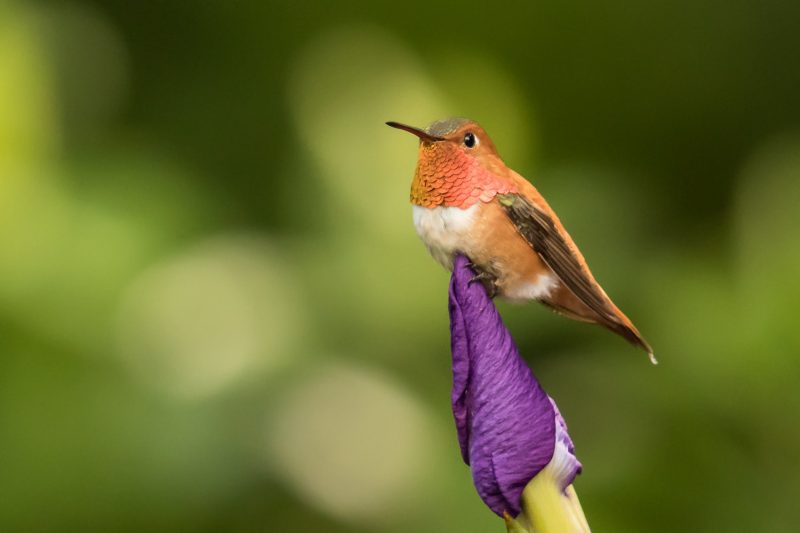
Appearance and Identification
The Rufous Hummingbird is a fiery jewel among North America’s smallest birds—and one of Michigan’s most exciting rare visitors. Adult males are instantly eye-catching with their brilliant orange body, coppery back, and blazing red throat that shimmers like molten metal in the sunlight. Their tails, also rufous in color, flash like embers in flight. Females and immature birds are less vividly colored but still striking. They resemble female Ruby-throated Hummingbirds but typically show more rusty tones on the flanks and tail, along with greenish backs and faint streaks on the throat.
Their compact size and rapid, darting flight make them a challenge to spot, but their bold colors and aggression at feeders help them stand out. When hovering near blossoms or sugar-water stations, they often fan their tails wide, revealing cinnamon and chestnut tones that can aid in quick field identification.
Habitat and Behavior
Native to the mountainous west, Rufous Hummingbirds are known for their astonishing long-distance migration, traveling farther north than any other hummingbird species—even into southern Alaska. Though they breed primarily in the Pacific Northwest, a number of individuals wander eastward during migration, and some make their way to Michigan in late fall.
In Michigan, they are most often reported at nectar feeders between October and November, sometimes lingering into December. Their presence is especially noted in the southern half of the state. Rufous Hummingbirds are notoriously territorial, even more so than the resident Ruby-throated Hummingbirds. At feeders, they’ll chase, dive-bomb, and fiercely defend their food source, often appearing as a fiery blur.
Their brief autumn appearances add a burst of color to cold Michigan days, and their hardy nature allows them to survive frosty conditions—making every Rufous sighting a thrilling encounter for local birders.
2. Anna’s Hummingbird (Calypte anna)
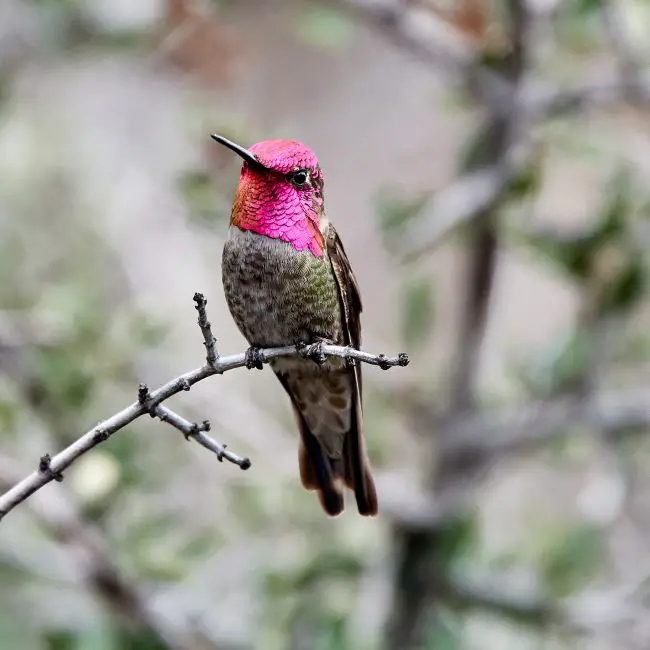
Appearance and Identification
Anna’s Hummingbird brings an unexpected flash of color and energy to cold-weather landscapes. Adult males are stunning in the right light, displaying an iridescent rose-pink crown and throat—a feature that can look dark or black in shadow but explodes into brilliant magenta when caught by the sun. Their bodies are mostly metallic green with a slightly gray belly, giving them a jewel-like appearance. Females lack the full pink head but show a splash of color on the throat along with green backs and a more muted overall tone.
Compared to the Ruby-throated Hummingbird, Anna’s appears slightly stockier and often holds its tail differently in flight. While its size and shape might not immediately distinguish it, its glowing pink crown and throat—especially in males—are unmistakable in good lighting.
Habitat and Behavior
Native to the Pacific Coast of North America, Anna’s Hummingbird is not a regular visitor to Michigan, but its range is expanding eastward. Winter sightings in Michigan are rare but growing, often linked to unseasonably warm conditions and the increasing presence of heated nectar feeders.
One of the few hummingbird species that can tolerate cold weather, Anna’s is known to overwinter in places as far north as British Columbia. Its ability to enter torpor—a state of slowed metabolism—allows it to survive cold nights that would be fatal to most hummingbirds.
Anna’s are also noted for their acrobatic courtship displays, during which males fly high into the air and then dive steeply while producing a distinctive mechanical sound from their tail feathers. Their sharp, buzzy vocalizations can be surprisingly loud and often alert birders to their presence long before they’re seen.
For Michigan birders, spotting an Anna’s Hummingbird in winter feels like a small miracle—a colorful visitor from the Pacific who braves the cold and brings a spark of life to a snowy garden.
3. Broad-billed Hummingbird (Cynanthus latirostris)
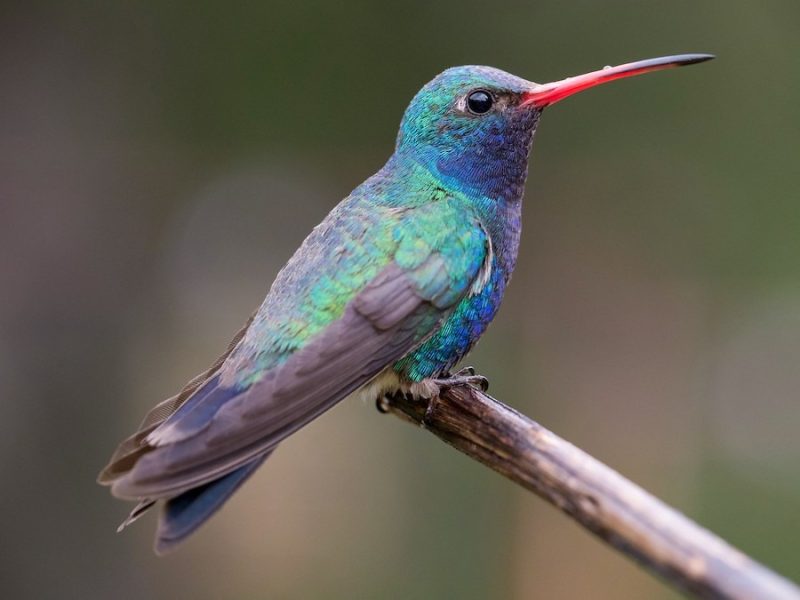
Appearance and Identification
The Broad-billed Hummingbird is a dazzling tropical species with a vivid, almost jewel-like appearance. Males are especially stunning, featuring a shimmering blue-green body, bright turquoise throat, and a long red bill tipped in black that curves ever so slightly downward. Their iridescence shifts dramatically with light, often turning metallic blue or emerald green depending on the angle. Females are less vibrant but still show a green back and white underparts with a noticeable eye-line.
This species also has white undertail coverts, helping to distinguish it from similar hummingbirds. Its long wings and streamlined body give it a sleek, aerodynamic look that’s hard to miss once spotted.
Habitat and Behavior
A native of Mexico and the American Southwest, the Broad-billed Hummingbird is built for sun-drenched canyons and desert blooms. In Michigan, however, it is an exceptionally rare vagrant, recorded only a handful of times. Most sightings occur at hummingbird feeders during late summer or early fall, often surprising backyard birders who are quick to notice the flash of a red bill or deep blue throat.
These hummingbirds are drawn to the same sugar-water sources as Ruby-throated Hummingbirds but may not stay long. Their presence is fleeting—typically a few hours to a few days—but unforgettable. Because of their rarity and brilliant coloring, Broad-billed Hummingbirds are considered one of Michigan’s most exciting and sought-after hummingbird discoveries.
A visit from this southwestern gem can electrify a backyard or park with tropical brilliance, reminding birders just how unpredictable migration patterns can be—even in the Great Lakes.
4. Costa’s Hummingbird (Calypte costae)
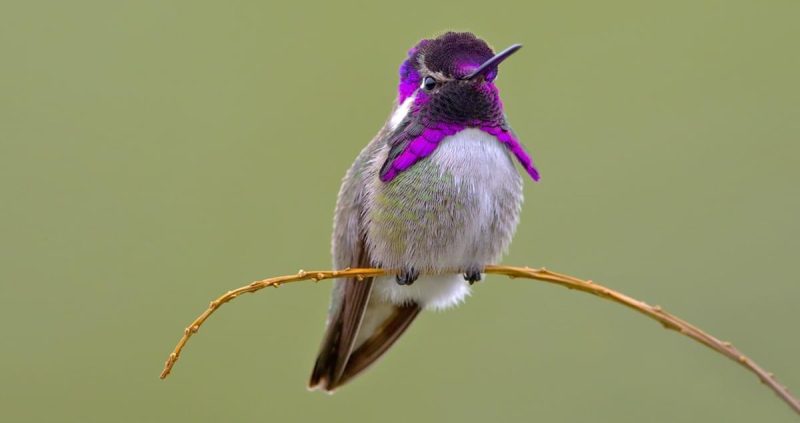
Appearance and Identification
Costa’s Hummingbird is a compact, desert-dwelling species that dazzles with one of the most exotic color displays among North American hummingbirds. Males are especially striking, with a deep purple crown and throat that extends in long flaring streamers down the sides of the neck, giving the appearance of a hood or royal ruff. When light strikes just right, the purple turns electric, shimmering with intensity. The rest of the plumage is a soft green on the back and a pale grayish-white underneath.
Females and juveniles lack the vivid purple gorget but retain the green upperparts and pale bellies. Their understated elegance, along with a shorter, slightly curved black bill, sets them apart from similar hummingbirds.
Habitat and Behavior
Native to the arid regions of the American Southwest and northwestern Mexico, Costa’s Hummingbird thrives in scrubby deserts and cactus-strewn canyons. Its compact size, quiet demeanor, and affinity for sun-soaked blooms make it a specialist in hot, dry climates.
In Michigan, Costa’s Hummingbird is an extremely rare vagrant, likely blown off course or displaced during migration. Sightings are scarce, but when they do occur, it’s often at nectar feeders in late fall. Because of their unusual coloration and small size, they are instantly recognizable if seen well.
Costa’s males are known for their spectacular courtship displays, including high-speed loops and dives accompanied by buzzing wing sounds. Though rarely observed in Michigan, even a brief visit from this desert beauty is a moment of magic for any Great Lakes birder.
5. Mexican Violet-ear (Colibri thalassinus)
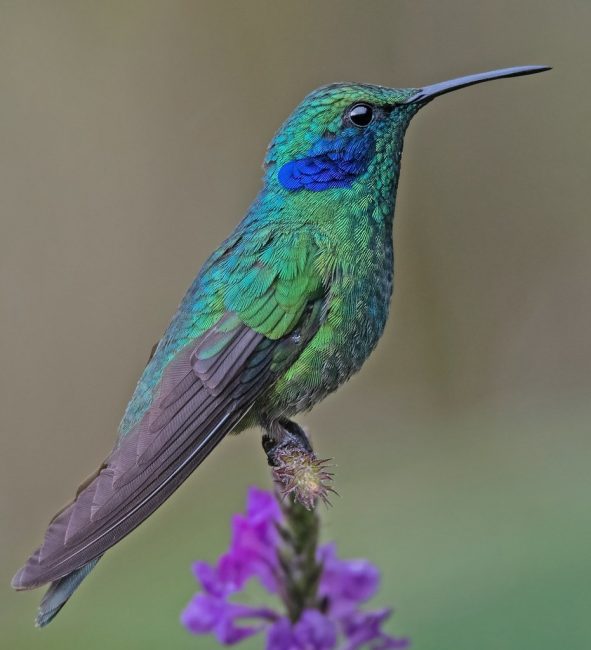
Appearance and Identification
The Mexican Violet-ear is a large, bold hummingbird that glows like a gemstone under sunlight. Its plumage is a rich, iridescent green that shimmers with blue or turquoise hues depending on the angle of light. The standout feature is the vivid violet patch on each cheek and the upper breast, giving this bird its name. These purple “ears” contrast dramatically with its otherwise emerald body, making it one of the most unmistakable hummingbirds in North America.
This species also has a straight, dark bill, medium-length tail, and slightly down-curved wings when perched. Larger and bulkier than Michigan’s familiar Ruby-throated Hummingbird, the Mexican Violet-ear has a presence that demands a second look.
Habitat and Behavior
Native to humid highland forests from southern Mexico to northern South America, this species is comfortable in lush, montane environments filled with flowering trees and shrubs. It is not migratory in the traditional sense but may wander widely, especially after breeding or when food sources are scarce.
In the U.S., the Mexican Violet-ear is primarily a rare visitor to Texas and the Southeast, but a handful of credible sightings have been recorded in Michigan, often at well-maintained backyard feeders or unexpected natural areas during summer or fall. When present, they may stay for several days, aggressively guarding feeders and chasing off smaller hummingbirds.
Their electric plumage and unusual size make the Mexican Violet-ear an unforgettable sight—and a thrilling surprise for any Michigan birder lucky enough to catch it glittering among the blossoms.
6. White-eared Hummingbird (Hylocharis leucotis)
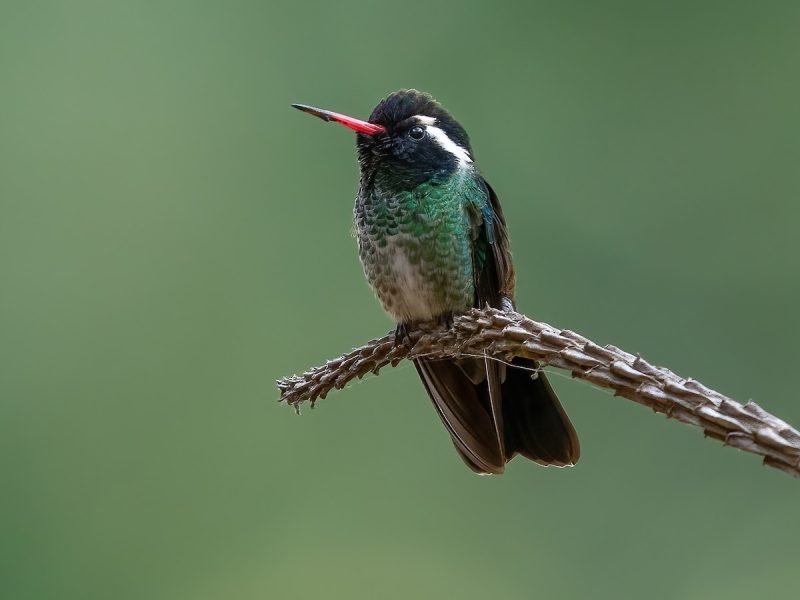
Appearance and Identification
The White-eared Hummingbird is a small but distinctive species, known for its bold facial pattern and colorful bill. Adults display a rich green back, grayish underparts, and a prominent white stripe extending behind the eye—hence the name “white-eared.” This stripe is especially striking against the dark green head. Males also boast a brilliant emerald gorget, though it can appear dark unless seen in strong light. One of the easiest ways to identify this bird is by its reddish bill with a black tip, which adds a splash of color to its compact form.
Though similar in size to the Ruby-throated Hummingbird, the White-eared Hummingbird’s facial markings and two-toned bill make it easier to distinguish when seen clearly.
Habitat and Behavior
Native to the pine-oak forests and montane woodlands of Mexico and Central America, the White-eared Hummingbird prefers cooler, high-elevation habitats filled with wildflowers. It is primarily a resident species, but some individuals wander northward, especially during post-breeding dispersal.
In the United States, it is most commonly observed in southeastern Arizona and occasionally Texas and New Mexico. A possible undocumented sighting in Michigan has intrigued local birders, though official records remain sparse. Any confirmed visit would be extraordinarily rare.
Despite its small size, this hummingbird is quite feisty. Males often perch conspicuously to defend nectar-rich areas and are not shy about chasing away larger birds. If one were to show up in Michigan, its unique facial markings, vibrant gorget, and colorful bill would make it stand out among the usual hummingbird visitors—rewarding those who look closely at every flickering wing.
7. Berylline Hummingbird (Amazilia beryllina)
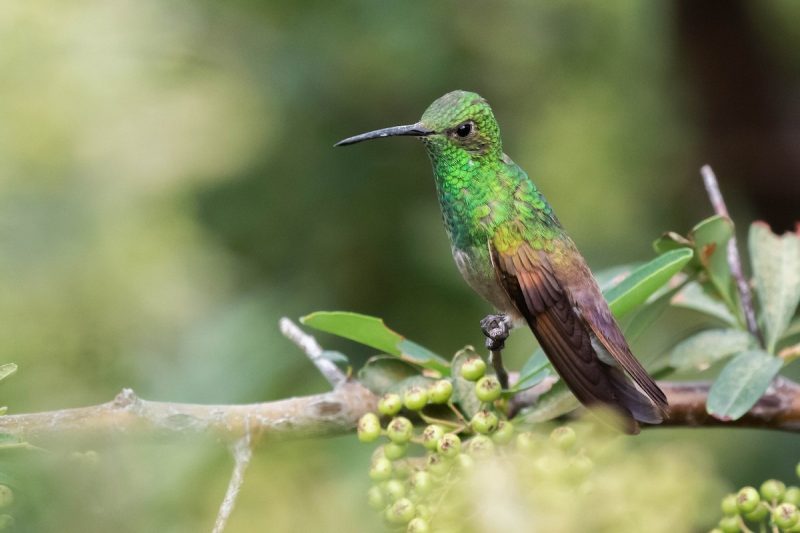
Appearance and Identification
The Berylline Hummingbird is a vibrant, tropical species with an exotic blend of colors that instantly captures attention. Adults are primarily a rich, emerald green across the head, back, and throat, glowing brightly when hit by sunlight. What sets this species apart is its rufous or cinnamon-colored underparts and undertail, which contrast beautifully with the green upper body. The tail is slightly forked and often appears a darker bronze or chestnut hue.
Males and females look relatively similar, though males tend to have more extensive iridescence and a brighter metallic sheen on the throat and chest. The bill is medium-length, straight, and mostly dark, with just a hint of reddish coloration at the base in some individuals.
Habitat and Behavior
The Berylline Hummingbird is native to the montane forests and oak woodlands of Mexico and northern Central America, where it thrives in elevations filled with flowering trees and shrubs. It is known for its bold, somewhat chunky appearance and slightly larger size compared to other hummingbirds.
Although primarily a resident species in its native range, the Berylline has made extremely rare appearances in the United States, mostly in southeastern Arizona and occasionally Texas. Reports of this species in Michigan are few and far between, with only a small number of unconfirmed sightings over the past decade. These possible vagrant individuals may be wandering post-breeding birds or displaced by storms.
If one were to visit a Michigan garden, its combination of brilliant green upperparts and cinnamon underparts would stand out starkly against the more familiar Ruby-throated Hummingbird. Its presence would undoubtedly generate excitement in the birding community, marking a once-in-a-lifetime encounter with a jewel from the tropics.
Conclusion
While Michigan may only host one hummingbird species regularly, these seven rare and vagrant hummingbirds have added color, excitement, and unpredictability to the state’s birding community. Whether it’s a fiery Rufous at a snowy feeder or a shimmering Violet-ear appearing after a storm, these unexpected guests prove that even the rarest of birds can find their way to the Great Lakes. Keep your feeders up in late fall, scan each visitor carefully, and you just might witness one of these dazzling migrants for yourself.






